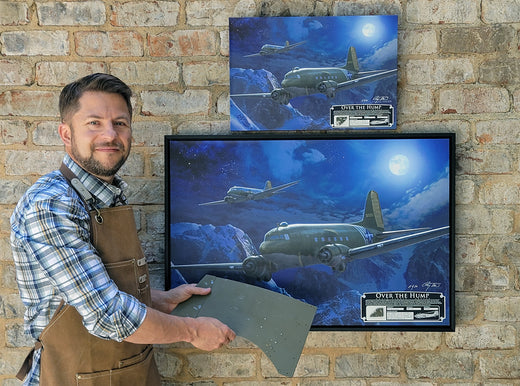This Fine Art Print by Artist Craig Tinder depicts the early years depicts C-47 cargo aircraft flying a perilous mission through the Himalayan Mountains - known as "the hump." This Limited Edition Canvas Print includes a fragment from a C-47 Skytrain and Certificate of Authenticity.
Details About the RELIC:
This is an actual fragment of aluminum from the cowl flap of C-47 S/N 41-7723. This aircraft was built in February 1942 and served in WWII. The aircraft later served with the Minnesota Air National Guard and Davis Montham Air Force Base. Each fragment is cut from a larger cowl flap panel and still retains some paint, rivets, and grime.
 Artist, Craig Tinder, holding a piece of the aluminum cowl flap that is used as the relic included in the "Over the Hump" limited edition prints
Artist, Craig Tinder, holding a piece of the aluminum cowl flap that is used as the relic included in the "Over the Hump" limited edition prints
 Detail photo of the art print's dataplate and attached relic
Detail photo of the art print's dataplate and attached relic
The Story Behind the Print:
With Japan’s invasion of China in World War II, the Allies were cut off from their main supply routes to Chinese forces. The only way to continue the flow of essential supplies was by air, through a dangerous path known as "flying the Hump." This route crossed the eastern end of the Himalayan Mountains, a region notorious for its treacherous conditions, including severe turbulence, unpredictable weather, and towering mountain peaks. Allied pilots flew through thick clouds, strong winds, and some of the worst flying conditions in the world to keep China supplied in its struggle against the Japanese.
The aircraft most commonly used for these missions were cargo planes such as the C-47 Skytrain, C-46 Commando, and later the larger C-87 Liberator Express. These aircraft had to navigate narrow mountain passes and often carried loads far exceeding their designed capacity. Pilots faced additional hazards such as mechanical failures, lack of navigational aids, and the threat of Japanese fighter attacks. The severe weather caused many aircraft to crash into the mountains, leading to the route being dubbed the "Aluminum Trail" due to the large number of wreckages scattered across the landscape.
The Tenth Air Force, along with the Air Transport Command (ATC), played a critical role in flying the Hump. Between 1942 and 1945, these units transported over 650,000 tons of cargo, including food, fuel, ammunition, and medical supplies, into China to support the war effort. In recognition of this vital mission, the ATC was awarded the Presidential Unit Citation in 1944, becoming the first non-combat organization to receive this honor. The pilots and crew who flew the Hump overcame incredible odds, ensuring that China could continue its resistance against Japan, and their efforts remain one of the most challenging and heroic logistical feats of the war.
To purchase or see similar items, visit here.
Commissioned by Museums, Treasured by Collectors





Share:
Pacific Skies, the story behind "Tainan Kokutai"
Military Vehicle and Collectibles Show - Denton, NC